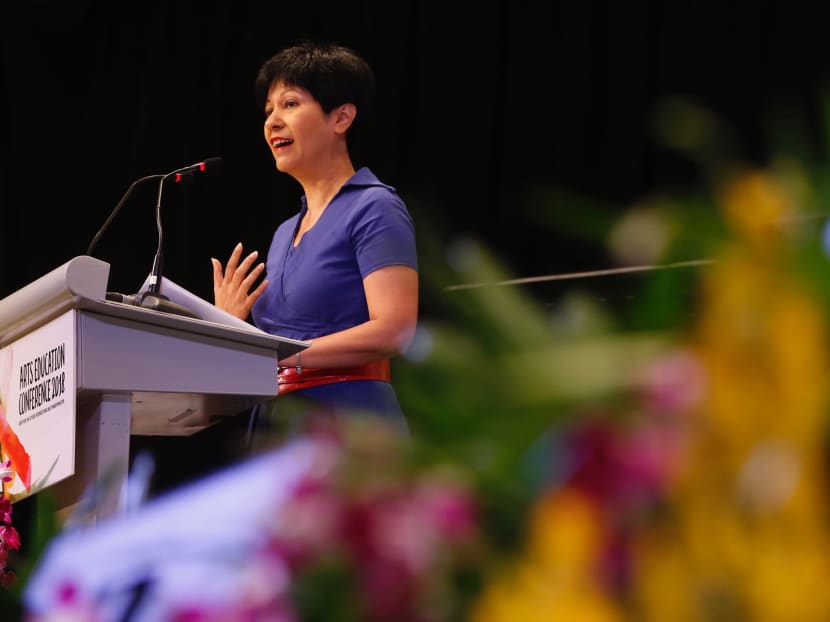Revamped DSA scheme to give students from disadvantaged families a leg up
SINGAPORE — Acknowledging that students from well-off families are in a better position to utilise the Direct School Admission (DSA) scheme, Second Minister for Education Indranee Rajah stressed on Thursday (Nov 8) that the latest refinements to the scheme will give students from disadvantaged backgrounds a leg up.

The latest adjustments to the Direct School Admission scheme will make it more accessible to applicants, including those who are not so "well-resourced", Second Minister for Education Indranee Rajah said.
SINGAPORE — Acknowledging that students from well-off families are in a better position to utilise the Direct School Admission (DSA) scheme, Second Minister for Education Indranee Rajah stressed on Thursday (Nov 8) that the latest refinements to the scheme will give students from disadvantaged backgrounds a leg up.
For years, critics have pointed out that the scheme — introduced in 2004 — has deviated from its original objective. It was started with the aim of recognising and admitting students into secondary schools based on talents in areas such as sports and arts instead of general academic ability.
However, affluent parents have been gaming the system by sending their children to preparatory schools to give them an edge in a bid to secure a place in top schools. Such practices led Ms Denise Phua, Member of Parliament for Jalan Besar Group Representation Constituency, to call it an “open secret” that DSA benefited children from wealthier households.
Speaking to reporters on Thursday at the sidelines of the Arts Education Conference, Ms Indranee said that the latest refinements to the DSA scheme aim to “close the gap”.
This includes not charging for applications, which are done through a centralised portal. Right now, students have to apply to the schools directly for DSA, and some schools with a high volume of applicants charge a fee ranging from S$20 to S$50 for each application because they deploy external resources — such as manpower — to conduct assessments.
Ms Indranee said: “We want to make sure that those less well-resourced, less well-advantaged, still have the opportunity to apply, and to make it an available platform for them.”
SIMPLIFYING THE PROCESS
The Ministry of Education (MOE) declined to give a breakdown of the socio-economic status of students admitted through DSA. When asked by reporters if a higher proportion of well-off students enter secondary schools via DSA, Ms Indranee said that “those who are better resourced obviously have the greater ability to find out more, to apply more”.
“Those who come from disadvantaged backgrounds may not be as well-informed of some of the choices available, and opportunities available,” she added.
This is why the new centralised online portal will benefit the less-privileged households, helping parents who might not know how to navigate through the present application process.
“It’s very difficult when you have to go to different schools and make different applications, and you also think about the time that it takes. So it is our assessment that having an online portal also helps those from less advantaged backgrounds because it just simplifies the process,” she said.
While the MOE noted that all students can have access to DSA regardless of their background, a ministry spokesperson said that it will continue to work with schools to improve selection practices, to ensure that students from all backgrounds can benefit from the scheme.
OTHER REVISIONS
Several other revisions had been made to the DSA scheme earlier this year. One of them is that all secondary schools will be allowed to admit up to 20 per cent of their Secondary 1 intake for the four-year O-Level track under DSA from this year.
Schools have also discontinued general ability tests meant for students who apply for academic programmes under the scheme.
Before the revisions, parents pointed out that the scheme was skewed towards those who are academically bright, which is not aligned to its original intention.
Statistics from the MOE showed that last year, the ratio of students admitted based on academic areas and non-academic areas is about one in two. This year’s data is not yet available, the ministry said.
Over the years, critics have argued that DSA is akin to a backdoor to popular schools, including those offering the Integrated Programme (IP) that allows students to bypass the O-Level examination.
But the number of students securing places in IP schools via DSA appeared to have gone down, the latest statistics from MOE showed.
In the 2017 DSA exercise, all participating schools made 3,200 offers, with 40 per cent of them coming from IP schools. The total number of offers takes into account the multiple offers that some students receive, and do not refer to the number of students that have secured places.
This year’s exercise, where there were 3,800 offers, saw the number of offers from IP schools dropping to 30 per cent.
The MOE noted that the figures may shift as it expands DSA opportunities in schools, and encourages parents to choose schools which offer programmes that can develop their child’s strengths and interests, and are suitable to the child's learning pace.









